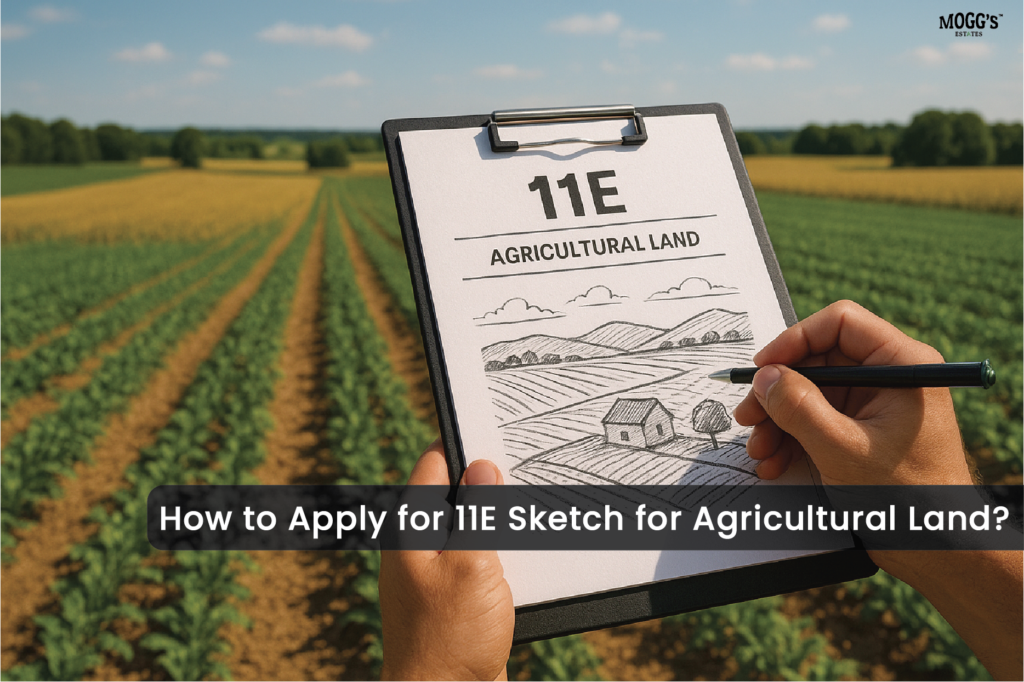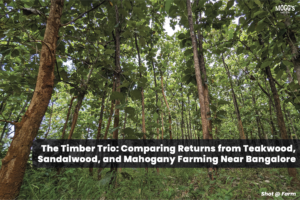Investing in farmland has become one of the most attractive opportunities in India today. With rising urbanization and an increasing interest in managed farmland projects, more investors are exploring agriculture as both a lifestyle choice and a wealth-building option. However, before entering this sector, it is crucial to understand the legal requirements surrounding agricultural land ownership.
One of the most critical documents in this regard is the 11E sketch. Whether you are buying, selling, or dividing agricultural land, this sketch plays a significant role in ensuring that your investment is secure. In this blog, we will explain what an 11E sketch is, why it matters for investors, and how to apply for it step by step.
What is an 11E Sketch?
An 11E sketch is a pre-mutation survey sketch prepared by the Survey Department. It comes into play when only a portion of agricultural land within a survey number is being sold, gifted, or divided among heirs.
For example, imagine a farmer owns 5 acres under a single survey number but wishes to sell 2 acres to an investor. The 11E sketch will clearly mark the boundaries of the 2 acres being transferred, ensuring there is no confusion in land records later.
In short, the 11E sketch ensures:
- Accurate land demarcation
- Transparent transactions
- Prevention of boundary disputes
- Smooth mutation (change of ownership in land records)
For investors in managed farmland, having a proper 11E sketch gives confidence that the land they are investing in is legally clear and well-documented.
Legal Basis of 11E Sketch
The requirement for an 11E sketch is rooted in the Karnataka Land Revenue Act, 1964, and its associated rules. Over the years, several High Court judgments have reinforced the importance of this sketch in land transactions.
At the same time, recent rulings have also given some flexibility. In some instances, courts have directed the Registration Department to proceed with registering sale deeds even when an 11E sketch is not provided. However, from an investor’s perspective, it is always safer to insist on this document for clarity and security.
Why is 11E Sketch Important for Investors?
When you invest in agriculture or farmland, especially in managed farmland projects, the 11E sketch provides an additional layer of legal assurance. Here’s why:
- Clear Boundaries – It removes any ambiguity regarding the exact land parcel you own.
- Smooth Registration – With a proper sketch, your sale deed is less likely to face delays or rejection.
- Avoiding Disputes – Future boundary or inheritance disputes can be prevented.
- Ease of Resale – If you decide to sell your farmland later, buyers will be more likely to trust your documents.
In short, an investor looking for stable returns from farmland should always prioritize properties with clear survey documents, including an 11E sketch.
Step-by-Step Process to Apply for an 11E Sketch
Applying for an 11E sketch is not complicated. Here’s how it works in Karnataka:
1. Collect Required Documents
Before applying, you need:
- RTC/Pahani (Record of Rights, Tenancy, and Crops)
- Aadhaar card of the buyer/seller or the partitioning parties
- Copy of the sale deed or partition deed
- Existing survey records of the land
2. Apply Online or Offline
- Offline: Apply to the local Survey Department or Taluk Office.
- Online: Use government portals such as Bhoomi or Kaveri (if available in your district).
3. Survey by Licensed Surveyor
A government surveyor will visit the farmland and prepare the sketch. In some cases, landowners can also opt for the Swavalambi survey scheme, where they can conduct a self-survey and get it verified by the Assistant Director of Land Records (ADLR).
4. Approval by ADLR
Once the survey is complete, the sketch must be approved by the ADLR office. This ensures the document is legally valid and recognized as such.
5. Issuance of 11E Sketch
After approval, the official sketch will be provided to the applicant. This can then be used for registration, partition, or mutation purposes.
Judicial Updates You Should Know
- Flexibility in Registration: Courts have directed that sale deeds should not be held up just because an 11E sketch is missing.
- Still Recommended: Despite this flexibility, investors are advised to ensure the sketch is in place, as it provides transparency and security.
- Digital Reforms: The government is gradually digitizing land records and making processes, such as the 11E sketch application, easier through online portals.
Investor’s Perspective: Why This Matters
If you are exploring farmland as an investment, here’s how understanding the 11E sketch benefits you:
- Risk Management – Agriculture land investments come with challenges like unclear titles, tenancy rights, and inheritance disputes. The 11E sketch minimizes these risks.
- Trust in Managed Farmland – Reputed companies offering managed farmland usually ensure all legal documents, including survey sketches, are clear before offering plots to investors.
- Future-Proofing – A legally sound farmland investment ensures better appreciation and easier resale.
Think of the 11E sketch as a safety lock that safeguards your agricultural investment.
Conclusion
Farmland has evolved into more than just an agricultural resource—it is now an asset class that combines lifestyle, sustainability, and returns. With managed farmland projects gaining popularity, investors must pay close attention to the legal side of agriculture.
Among the key legal requirements, the 11E sketch stands out as a vital document that ensures transparency, prevents disputes, and gives confidence in ownership.
If you are planning to invest in farmland, always ask:
- Does the land have a proper 11E sketch?
- Does the ADLR approve the survey?
- Are mutation and registration records updated?
By doing so, you not only secure your investment but also pave the way for a smooth, rewarding journey into agriculture and farmland ownership.




